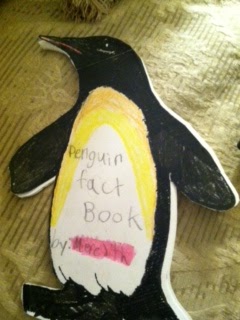It is true, that as a teacher, you are a lifelong learner. This week our reading selection was called Penguin Chick. I've always loved this selection because it is nonfiction and tells so many interesting things about Emperor Penguins. My kids really got into the selection this week; they all came back from the library with books about either penguins or Native Americans (our social studies topic) and couldn't wait to show me all that they found.
Here are some interesting things my kids and me learned this week about Emperor Penguins. There are seventeen different species of penguins. The Emperor Penguin lives in the cold continent of Antarctica. The female penguin lays one egg at time. After she lays the egg, she is starved and must go look for food. The father stays with the egg because he is fatter and can live longer without nourishment. The father keeps the egg warm in his brood patch. For seventy days, the mother journeys to the sea to look for fish, shrimp, and krill that she swallows whole. The journey is not easy; it is cold and long. It is winter in Antarctica during this time and the ocean is frozen for miles and miles. The mother penguin marches until she reaches the water and eats until full, then she begins the journey back to the rookery. In the meantime, the father keeps the egg in his brood patch, balanced on his feet. The father penguins huddle together to keep warm. The eggs eventually hatch. It takes three days for the baby penguins to emerge. The father keeps the baby in his brood patch, as the frigid temperatures will kill the baby quickly. Finally the mother returns. She feeds the baby by regurgitating her food (my kids thought this was the grossest thing ever). The very hungry father then leaves to find food. The mother ate enough to keep her, and the baby alive for weeks.
The baby penguin grows and grows. Soon, he is big enough to venture from his mother's brood patch. He and the other baby penguins huddle together in the rookery to keep warm. They also enjoy tobogganing on their bellies. At five months old, the baby penguin is old enough to take his own journey to the sea to find food. At five years old, the penguin will find a mate and have a baby egg to take care of, too.
Our reading project this week was to use multiple nonfiction texts to collect facts about penguins. Here is an example of one below:






No comments:
Post a Comment